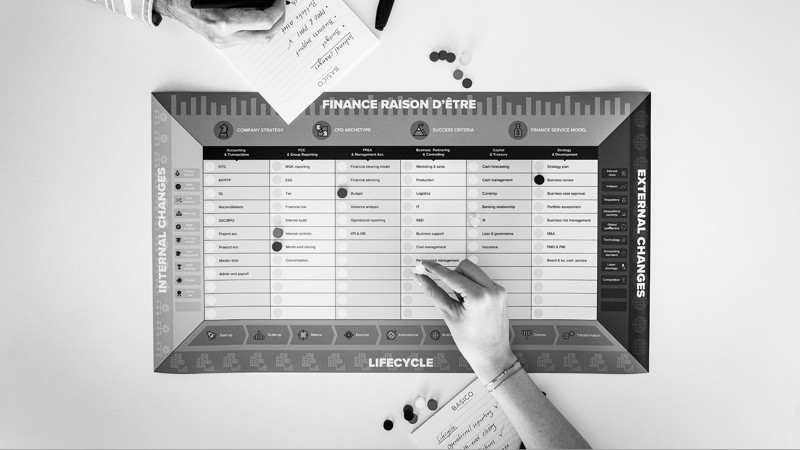With the CFO Gameboard, you get your entire finance function laid out in front of you, allowing you to identify your greatest opportunities and most pressing fires with precision – and map out how to best extinguish them. In this article, you get an introduction to the 'rules of the game', so you can be tempted to play.
If managing and designing a finance function were a one-size-fits-all exercise, life as a CFO would be somewhat easier. But because the well-functioning finance function depends on a wide range of company-specific parameters, it is difficult to talk about a so-called best practice for finance. This is what Managing Partner at Basico Jacob Poulsen explains.
"That is why I actually do not like the term 'best practice'. Because the answer varies greatly depending on what kind of company is asking. And what the CFO discovers in the process of making their finance function strong is that it is heavily dependent on several different factors.”
The purpose of the game
This reality has formed the basis for the diagnostic tool disguised as a board game that Basico has developed. The CFO Gameboard is designed to analyse, map out and optimise the financial function in a company.
The game helps identify challenges and opportunities as well as prioritise focus areas based on your company's current situation. As a CFO, you can sit down in front of the game board and focus sharply on the reality of your finance function.
"With the gameboard, you essentially get a dialogue tool to figure out where your finance function is challenged and where the opportunities lie. It forms the basis for conducting an analysis and having a good dialogue, which can be translated into how you should build your finance operating model to support it – and how you can actually convert the situation into concrete changes by developing one or more robust roadmaps," says Jacob Poulsen.
Starting the game
The game board is square with four outer frames. In the center of the board, you find more than 40 fields, which are divided into six columns. We will return to those.
The game begins with you first turning your focus to the upper frame of the game board. Here you define your finance function's raison d'être using four sub-points, each of which are important elements in mapping out what role finance plays in your company. This forms the basis for a discussion about the company's strategy for finance, the function's success criteria, what the service model looks like and, not least, your background as CFO and personal profile.
"There is a big difference whether you as CFO have your background in, for example, auditing or investment banking, or have made a career internally in the company's finance function. Because we all have different blind spots and strengths, and this helps drive where your focus as CFO lies. Therefore, it helps define the areas you should focus on in your finance function when you get further into the game," says Jacob Poulsen.
Once the finance function's reason for existence is established, you move on to the bottom frame of the board. Here it is about the company's different life phases, where the game board presents nine defined company stages. It is one thing to settle in and design a finance function within each individual life phase, but the focus is particularly on the transformation phases. Because where is your company located? And what does it require of finance to be geared toward where the company is heading?
Executing a transition from, for example, being a scale-up to becoming a mature company – or if the company aims to go international or become "truly global" – is something that demands extremely much from you as CFO and from your finance function.
"It is a bit like having children," says Jacob Poulsen. "It is a huge upheaval to have them, but gradually you learn to navigate and find your place in that life phase. But when they then, for example, move away from home, it is again a huge transformation that you need to adjust to. In the same way, the transformation phases are enormously difficult to navigate as a finance function."
On the left side of the board, it is about the internal changes that the company itself decides. This could be, for example, a new organisational chart, a new product diagram, a new director or a new ERP system. On the right side, it is about the conditions caused by external factors such as new legislation, a new global situation, changed supply chains or a new competitor.
"So before you start making major changes, you should first map out your finance function's raison d'être, your strengths and weaknesses as CFO, the function's life cycle and perhaps even transition and the various internal decisions and external conditions that affect finance. All these elements are combined to analyse what the right way is to make your finance function perform well.”
Playing the game
Focus now turns to the center of the game board. Here you find more than 40 fields, each representing the individual components of the finance function. The fields are divided into six columns, which together make up the structure of the finance function. Below you can read an ultra-brief description of each column:
Column no 1: Accounting & Transactions
The engine room of the finance function. All transactions must be recorded correctly and in a timely manner to ensure an accurate data foundation for all further cash flow, reporting and analysis. The focus is on efficiency.
Column no 2: FCC & Group Reporting
Compliance with regulatory requirements and correct financial tax and ESG reporting, control environment and internal audit etc. The focus is on ensuring reporting occurs without errors.
Column no 3: FP&A & Management Accounting
Business-oriented financial management, planning and operational reporting as well as key figures etc. The focus is on "making numbers talk" and steering the overall economic direction.
Column no 4: Business Partnering & Controlling
The combination of financial insights, commercial understanding and human qualities is used to make business decisions – often in a narrow area – and in close collaboration with area management. The focus is on value creation.
Column no 5: Capital & Treasury
The company's banking business in a broad sense. Liquidity and capital management, insurance and risk hedging. The focus is on cash flow and financing operations.
Column no 6: Strategy & Development
The future is now. Finance is used to shape the company you need to be in the future, through involvement in acquisitions, divestments, scenario planning and business cases for major investments such as program offices etc. The focus is on long-term business development.
All six columns have a number of predefined fields. In addition, there are also a number of empty fields where the individual company can dive into further details – depending on needs.

Based on the mapped situation from the game board's four outer frames, you now focus on where in your finance function there are challenges and opportunities, respectively. Specifically, you place game pieces in different colours, illustrating focus areas and fires of varying intensities, on the fields where you will prioritise efforts.
"What we experience when we play is that the CFO is forced to decide what really matters. That is, what is urgent, what creates truly great value in the long run, and how, as CFO, you balance between the two. You can mark these with 'fires,' and then the task afterward is to extinguish and reduce the number of fires, as well as to see what opportunities this gives you. This way, you are forced to prioritise your efforts," explains Jacob Poulsen, who continues:
"The easiest thing for us as consultants is to prepare long reports with everything that can be initiated. The difficult – but also the most rewarding ‒ is to be in dialogue with the CFO about what is the right thing to initiate."
At the same time, you also choose some "no regret moves." These are initiatives that can be started now, which you as CFO will not regret. It is a method to get something going immediately, before the complete analysis is finished, so that everything does not get caught up in project plans and prolonged analytical work.
Additionally, you also place game pieces that indicate your must-win battles.
"Must-win battle is a somewhat worn expression, but the black pieces in the game are those that could cost the job of either the CFO we are playing with, or in the worst case, their boss. These are the things that require all of one's energy and resources," as Jacob Poulsen explains it.
Finishing the game
A round of the game finds its conclusion when you have carried out a thorough prioritisation and thereby moved the pieces to their most optimal positions. Here you will have gained insight into how your finance function becomes a strategic player that can be crucial for the company's development. Through the game, you have not only mapped out where the challenges lie, but also where the potential is hidden.
But one thing is to see the challenges, opportunities and visions unfolded on the game board. Another is to take the insights out into reality. Because the CFO Gameboard has not only been created to talk about the challenges. It should also encourage action.
"When the pieces are positioned where they should be, the task becomes to convert the pieces' placement on the board into actual action plans in the form of roadmaps or smaller projects. These are described on initiative cards, where the CFO goes into detail with each piece's placement and figures out the possible measures and their internal dependencies," explains Jacob Poulsen.
With a clear prioritisation and a sharper eye for what really drives change, you as CFO can take control and shape a finance function that actively supports and accelerates the company's overall strategy.
Because just like in any good game, it is not enough to know the rules – you need to dare to make the decisions, lay out your strategy and act on it.

Ready to play the CFO Gameboard with your finance function in focus?
We are happy to unfold the game board in front of you, so together we can identify your challenges and opportunities – and how you can take your finance function to the next level.

 en
en
 da
da


